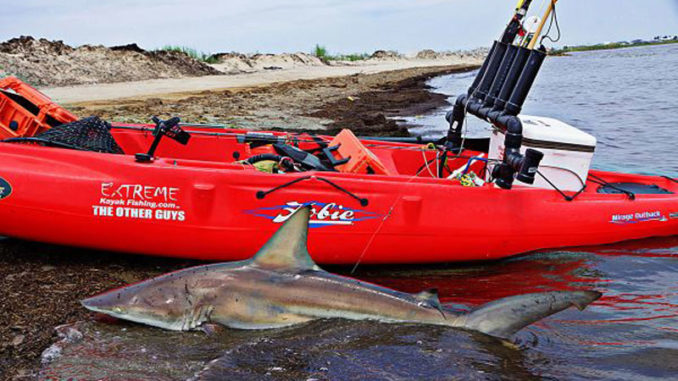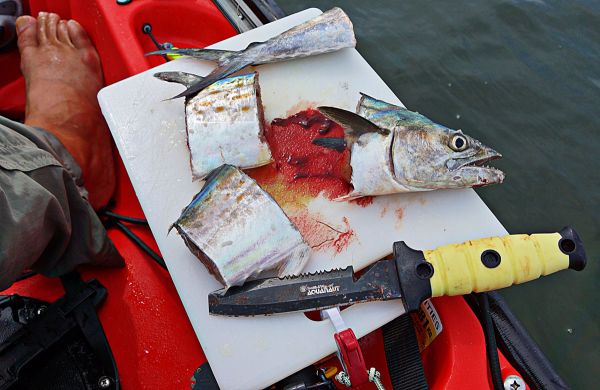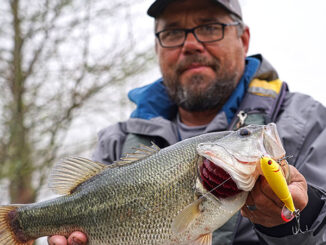
Common sense is No. 1 tool
If you kayak fish in coastal Louisiana, sooner or later you will hook into a shark. It’s not a matter of if, but when. Being prepared ahead of time means both the angler and fish can leave the encounter unscathed.
Many sharks have been hooked by kayak anglers in places where they were least expected. With the prevalence of brackish water, sharks have even been encountered while fishing for freshwater species such a black bass.
Kayak anglers not wanting a shark visit are advised to refrain from using stringers to keep their fish. Sharks will readily attack a fish-laden stringer hanging off the side of a kayak.
There’s really nothing you can do to prevent a shark from hitting your line. This is especially true if you are using live or dead natural baits. However, they are also often caught on scented plastics such as Gulp!, and will sometimes even strike unscented artificial lures.
Sharks are strong fighters and make for excellent sport when fought from a kayak. If you are not specifically targeting them, chances are you will be using monofilament or fluorocarbon leaders. It is highly likely that the sharks razor-sharp teeth and/or sandpaper-like skin will cut the leader before getting a chance to land the fish.
However, if hooked in the corner of the mouth, there is a chance that you will land the shark ’yakside. What now?
What to do if you hook a shark
The best practice is to simply cut the leader as close as you can safely get to the shark’s mouth. The hooks will eventually rust out and the short leader will likely not prevent the shark from feeding or get tangled.
This greatly decreases the possibility of injury to the fish and fisherman from attempts to handle the shark.
Sharks are extremely powerful and flexible. An attempt to hold the shark by the tail can result in serious injury because the shark’s cartilaginous skeletons allows it to bend nearly in half. In other words, holding a shark by the tail doesn’t mean that it can’t reach you with its mouth. A bite or even the slightest brush against those teeth can cause serious injury.
If a shark is to be handled, it’s best to get control of the business end — its teeth.
A quality, long-handled lip-grip should be carefully attached to the shark’s lower jaw. With control of the jaw, the hook or lure can be removed with a pliers or hookout.
As noted above, if the hook cannot be safely removed, it’s best to cut the line.
But just because you have control of the head, do not neglect the tail. While not likely to cause serious injury by itself, a hard slap of a shark’s tail can easily knock a ’yaker out of the boat.
If conditions allow, paddling to shore to finish landing/releasing the shark is a good option.
Shark regs
Sharks also make for good eating, and Louisiana law allows anglers to keep one shark per day when the season is open. Shark season in Louisiana state waters is closed from April 1 through June 30 each year. Any sharks caught during this time must be released.
The minimum size limits on sharks mean that, for the most part, only large sharks can be kept. This is especially important to kayakers. With the exception of small coastal sharks such as Atlantic sharpnose and bonnethead, which have no minimum size, large coastal sharks must be a minimum of 54-inches measured from the tip of the nose to the fork of the tail to be legally kept. This means that almost all “keeper” sharks will be 5 feet or greater.
Other than a few obvious ones such as hammerhead and nurse sharks, shark species can be hard to determine. Several species of sharks are prohibited, so kayak anglers should study up on species identification before keeping any sharks for food.
Keeping a shark
If a kayak angler decides to keep a legal shark, it’s likely that will be the end of the day’s trip. Most kayakers do not have sufficient cold storage space onboard that’s necessary to properly care for a large shark.
To ensure angler safety and quality of the filets, the shark should be dispatched quickly. A small bat makes for an efficient and inexpensive tool to do the job. A few heavy blows to the back of the head will properly adjust the shark’s attitude.
Take the fish to shore, and gut and ice it well as soon as you can. Most sharks secrete uric acid through their flesh and skin, and left whole the meat will have a strong ammonia smell and objectionable taste. Once home and cleaned, the meat should be soaked in ice water for 24 hours before cooking or freezing.
Targeting sharks

If you decide to intentionally target sharks, gearing up with heavy tackle is a must. Sharks are strong fighters and using braided line of 50 pounds or above is advisable. Steel leaders ensure the shark will not cut or wear through during the fight.
Gloves, a bat and a quality lip-grip all come in handy when trying to land and subdue a dangerous shark. Sharks are not too picky and can easily be attracted with chunks of dead bait such as mullet, ladyfish and mackerel.
Sharks encounters in a kayak, intentional or not, are an exhilarating if not frightening experience.
When encountering a shark in a kayak, the No. 1 tool at your disposal is common sense. Sharks are powerful and dangerous, and a cut or bite while in a kayak can easily be a life-threatening situation.
If you have any doubts that the shark can be safely landed and handled, cut it loose.


